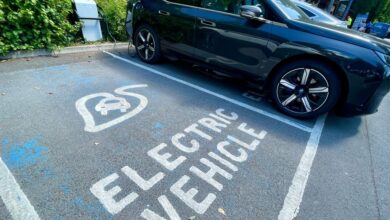Electric vehicle fires pose challenges for firefighters

Bristol Virginia Fire Department Captain Brandon Moore talks about the equipment used to assess electric vehicles when in a collision or fire.
It can take hours to fully extinguish an electric vehicle fire, compared to mere minutes to put out a gasoline powered vehicle fire, according to local firefighters.
“Fires involving electric vehicles present challenges for firefighters that are certainly unique and can require significantly more resources to extinguish than a typical vehicle fire,” said Tommy Castle, assistant fire chief at the Bristol Tennessee Fire Department.
The differences between gasoline powered vehicle fires and electric vehicle fires concern local firefighters.
People are also reading…
“EV fires are a nightmare,” Bristol Virginia Fire Chief Mike Armstrong said.
No U.S. agency or organization tracks the number of electric vehicle fires, but a Swedish authority does. The Swedish organization said that out of 611,000 electric vehicles, there have been about 20 fires per year in the last three years.
In comparison, with 4.4 million gasoline powered vehicles, there were 3,400 fires during that time, the organization reported.
Nearly every electric vehicle fire requires tens of thousands of gallons of water to control, but not completely extinguish, Armstrong said. Most will still smolder and often rekindle after being extinguished, he added.
The majority of the challenges associated with electric vehicle fires result from a phenomenon called “thermal runaway.” Castle said that can occur if the lithium-ion batteries in the vehicles short circuit, are overcharged or experience other conditions like collisions that may damage the integrity of the battery.
“Essentially, cells in the battery begin to overheat, causing the chemicals in them to break down, expand and rupture the cell, releasing flammable gases that can then ignite under the high temperatures,” Castle said.
The effect can produce a chain reaction by causing other cells in the battery to begin overheating, but at the chemical level, the additional heat and release of chemicals can speed up the reactions, resulting in an uncontrollable self-heating state, hence “thermal runaway,” Castle said.
Castle said the only way to suppress the fire is to try and cool the entire system to a point where the combustion reactions stop.
“This is done by applying water in large amounts to the area of the vehicle’s battery pack,” he said.
Most fire trucks can carry between 500 and 1,000 gallons of water, which Castle said is more than adequate to extinguish a gasoline powered vehicle fire in a matter of minutes, if not seconds.
Occasionally, firefighters can run into problems with gasoline powered vehicle fires, but Armstrong said most are fairly simple operations.
By comparison, however, an electric vehicle fire worked by Bristol Tennessee firefighters in May of 2022 required roughly an hour and a half and nearly 12,000 gallons of water to get under control.
Bristol Tennessee has not purchased any specialized equipment to battle electric vehicle fires, but firefighters have equipment, such as a piercing nozzle, which can be used to deliver large amounts of water on the vehicle.
Electric vehicle manufacturers have provided guidance and technical specifications to aid first responders in the event of an accident or fire, Castle said.
Once an electric vehicle is loaded onto a wrecker, Castle said it must then be followed by firefighters in the event that the battery spontaneously reignites during transport.
The vehicle must also be stored a safe distance from other vehicles, and HAZMAT protocols may need to be implemented to stabilize and mitigate potential water or soil contamination from battery chemicals.
Bristol Virginia firefighters have not yet had to battle an electric vehicle fire, Fire Chief Mike Armstrong said.
“I really believe it is just a matter of time,” he said.
Armstrong said he often sees electric vehicles at the new casino and local shopping centers.
“EVs are all around us,” he said. “It is not a matter of if, but when.”
In Virginia, Governor Glenn Youngkin has directed the state’s Department of Fire Programs to develop EV fire training for firefighters. That training is coming out later this year, Armstrong said.
Most fire departments have already begun to research the issue and come up with solutions, including both Bristol fire departments.
Armstrong said his department recently purchased a giant nylon blanket that can be deployed over the top of a burning electric vehicle to help smother the fire and protect nearby vehicles. The blanket cost more than $1,000 and is a one-time use.
The Bristol Virginia Fire Department also purchased a $950 device that inserts into an electric vehicle charging port on the vehicle that is supposed to help neutralize the electrical current inside the vehicle so it will not be able to drive away while firefighters battle the blaze, Armstrong said.
“We hope these two new items will help us get ahead of the situation,” Armstrong said.
dmcgee@bristolnews.com — Twitter: @DMcGeeBHC



